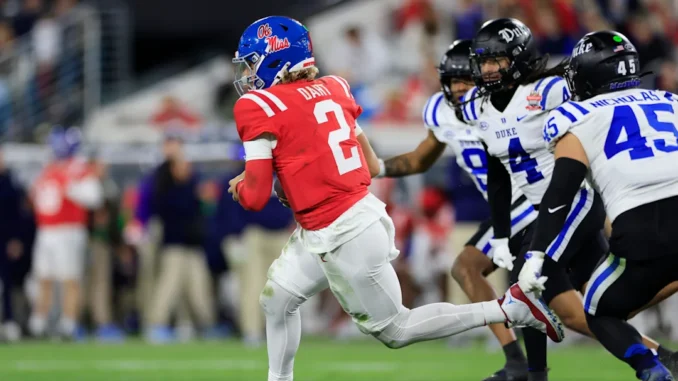
The TaxSlayer Gator Bowl, held on January 2, 2025, featured a commanding performance by the No. 14 Ole Miss Rebels, who secured a 52-20 victory over the Duke Blue Devils at EverBank Stadium in Jacksonville, Florida.
The game was broadcast live on ESPN, with kickoff at 8:00 p.m. ET.
The Gator Bowl attracted a television audience of approximately 5.03 million viewers.
This viewership places the Gator Bowl among the more-watched non-CFP (College Football Playoff) bowl games of the 2024–25 NCAA football season.
For context, in the 2021–22 season, the Citrus Bowl between No. 15 Iowa and No. 22 Kentucky garnered 6.5 million viewers, while the Music City Bowl between Tennessee and Purdue attracted 5.6 million viewers.
The Gator Bowl’s viewership of 5.03 million indicates a strong interest in the matchup, though slightly lower than some other prominent bowl games in recent years.
Several factors may have influenced the Gator Bowl’s television ratings.
The participating teams’ national profiles play a significant role; Ole Miss, representing the Southeastern Conference (SEC), has a storied football tradition and a passionate fan base, which likely contributed to higher viewership numbers.
Duke, primarily known for its basketball prowess, has been making strides in football, and its appearance in the Gator Bowl under first-year head coach Manny Diaz may have attracted additional viewers interested in the program’s development.
The timing of the game also impacts viewership.
Scheduled for January 2, the Gator Bowl benefited from a prime evening slot during the holiday season, a period when many potential viewers are at home and available to watch.
However, competition with other bowl games and sporting events can affect ratings.
In the 2024–25 bowl season, several games were scheduled around the same time, potentially dividing the audience.
Additionally, the performance of the teams during the regular season influences viewer interest.
Ole Miss concluded the season with a 10-3 record, achieving back-to-back 10-win seasons for only the second time in school history, which likely boosted interest among fans and neutral viewers.
Duke finished with a 9-4 record, marking a successful debut season for Coach Diaz, which may have piqued curiosity about the team’s performance in the bowl game.
The Gator Bowl’s viewership numbers also reflect broader trends in college football broadcasting.
In recent years, non-CFP bowl games have experienced fluctuations in television ratings due to factors such as the increasing number of bowl games, changes in viewing habits with the rise of streaming services, and varying levels of fan engagement depending on team matchups.
While the Gator Bowl’s 5.03 million viewers demonstrate solid interest, it also highlights the competitive nature of bowl season viewership, where games vie for audience attention amid a crowded sports landscape.
In summary, the TaxSlayer Gator Bowl between Ole Miss and Duke attracted a substantial television audience, reflecting the appeal of the matchup and the traditions of the participating programs.
The viewership figures align with trends observed in recent bowl seasons, underscoring the factors that influence audience engagement, including team profiles, game timing, and the evolving media consumption landscape.
Leave a Reply